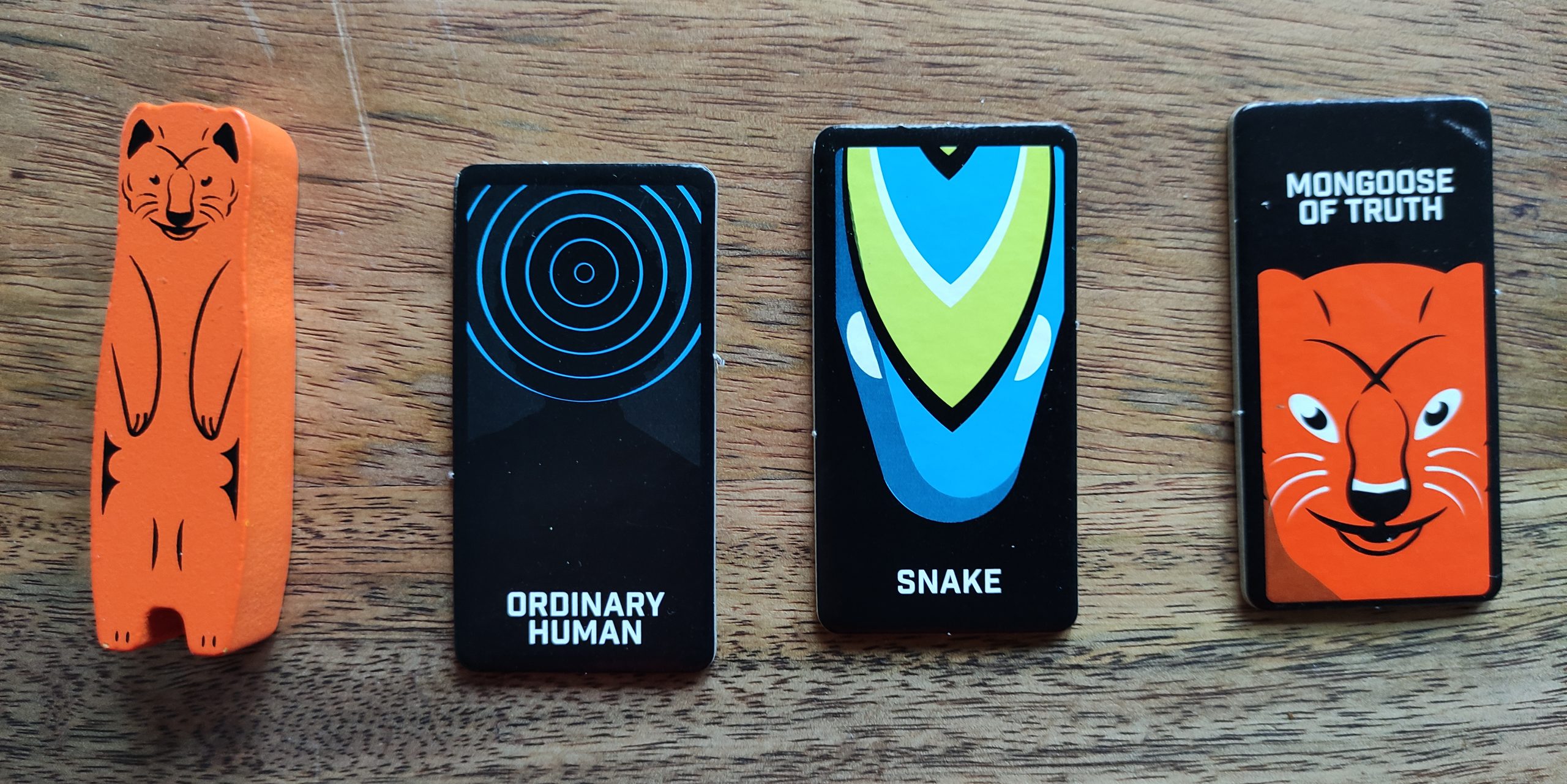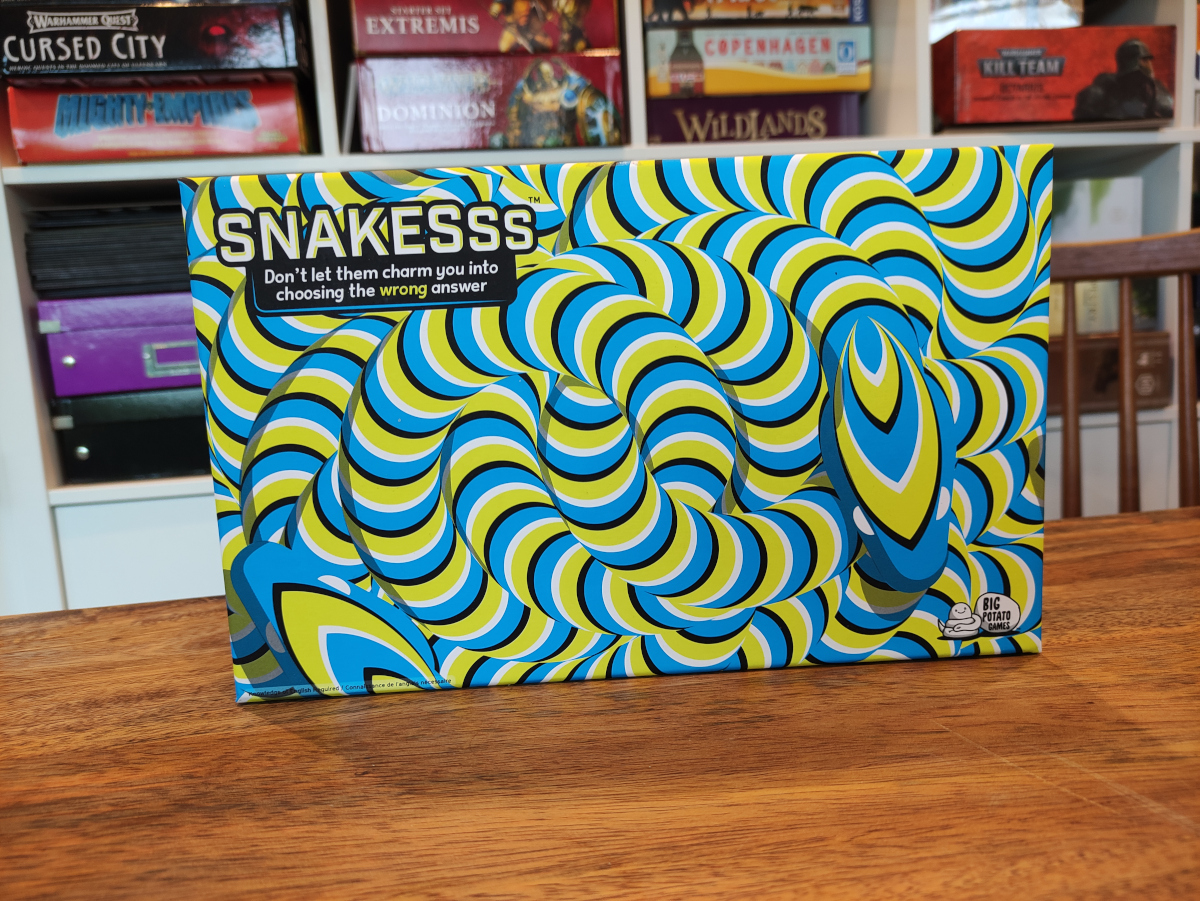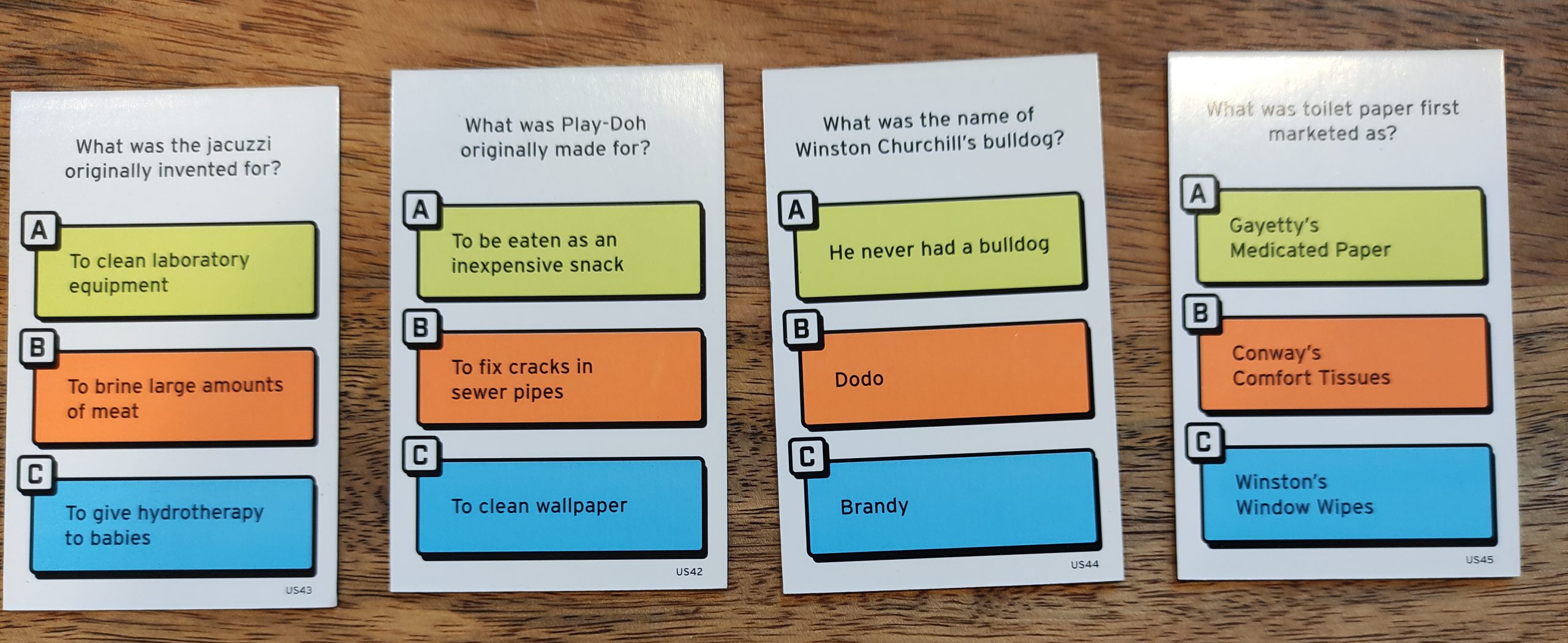Snakesss is a party game for 4-8 people that requires a little general knowledge and a whole load of bluffing.
What Is Snakesss?
In Snakesss players have to discuss a multiple-choice general knowledge question and come up with a conclusion as to the right answer. Or at least some of them do. One or two of you will be snakes in the grass; if you can convince the others that the wrong answer is the correct one, you win the points! Rounds are quick, and the age on the box is 12+. This is probably accurate as there are certainly no content reasons why it should be higher. My 12-year-old, however, can’t bluff, so he is terrible at this game.
What’s in the Box?
Fortunately, there are no actual snakes to be found in the box.
Instead, you will find:
- 120 question cards
- 8 Character Tokens
- 32 Answer chips
- 1 Score Pad
- 1 Moongoose figurine
A Mongoose figurine. What’s that doing in there?
Well, each round one player will be the “Mongoose of Truth.” This person is not allowed to lie in that round. They can be wrong about what their answer might be, but not deliberately.
The game is nicely presented. The pattern on box is mesmerizing in the extreme and arguably a little disconcerting. The components are all made from good card stock.

How a Snakesss Round Works
There are various ways to load out who plays what in a game of Snakesss. It’s all dependant on how many players there are. To be honest, I think the game needs at least 5 players to give enough variety of responses. I also think for new players, I think it is probably a good idea to have a separate moderator and question reader, but more on that later.
Roles are chosen at random and kept secret. The character tokens (pictured above) are shuffled each round and handed out face down. In any game there is always at least one ordinary human, at least 2 snakes, and 1 (and only 1) Mongoose of Truth.
The person who drew the mongoose gets the wooden mongoose token so that none of us forget who is always truthful.
Question Time
One person is chosen to be the moderator. They read out a question to the group, without revealing the answer to anybody (including themselves) that’s on the back of the card.
After that:
- Everybody closes their eyes (including the moderator).
- Eyes still closed, the moderator flips the card so that the answer is showing.
- The moderator says “Snakes, open your eyes.” The snakes do so and look at each other and the answer on the card.
- The moderator says “Snakes, close your eyes.”
- The card is flipped back over to the question side and everybody opens their eyes.
Find an Answer
After that, a two-minute timer is set (not included) and players debate the question and try to come to the right answer.
The snakes attempt to convince the other players of the wrong answer.
After the two minutes are up, each player places an answer token in front of them (There are 4: A,B, C, and Snake. Snakes just put the Snake token in front of them.)
Scoring
Scoring is a little moot, to be honest. The fun in Snakesss is definitely in the taking part rather than the winning. For those of you who are competitive, each person who wasn’t the snake that answers the question correctly is awarded one point for each person who answered correctly, including themselves. The snake players get a point for every person who answered incorrectly.
And that’s the first round. For those scoring, the game is meant to be played over 6 rounds.
Why Play Snakesss?
If you enjoy bluffing games, then Snakesss is definitely good fun. And for the right group of people, I can see this getting some repeated plays, at least until you’ve worked through the cards. If you play 6 rounds a session, that’s 20 games before you need to repeat questions. I don’t really have a feel for how many repeats plays each card can have. Possibly not much, as much of the game’s bluffing shenanigans requires players not to have a definite idea of the answer.
I like that some elements of bluffing might involve trying to convince someone of something you’re not sure is right. As snakes, if you don’t know the answer to the question, you may inadvertently lead the humans to the right answer, even though you thought it was wrong.
I must confess, however, that my playthroughs haven’t been entirely successful. The game doesn’t work very well in mixed bluffing ability groups. (I.e. families of young and old. Well, my family anyway.) It’s great having a mongoose of truth, but when this happens to be your extremely knowledgeable mom, the snakes are basically screwed.
Then there is the problem of the moderator. In theory, it’s fine, but the very act of asking people to shut and/or open their eyes, and having to do the same yourself, makes it very difficult to talk afterward without giving away whether you had your eyes open or not. (Remember rules as written, the moderator could be a snake or a human.) Bluffing your answer can be hard enough without trying to catch your own social ticks that might give away what you did during the snake reveal section of the game.
Finally, unless you’re a seasoned bluffer, it’s quite hard to bluff convincingly when playing Snakesss. As a human, either you know the answer or you don’t, and you say “I know this, because…” or you just be quiet and let other people speak. Whether you do or don’t know the answer, as the snake, you have to try to make up something convincing. It’s actually surprisingly difficult to make up a convincing argument that is plausible without sounding that’s exactly what you’re doing. It’s very easy to over-explain and give the game away.
Snakesss has an interesting premise for a game. It’s always good to see new variations on popular themes—in this case, the bluff. Having played a few hands with a couple of different groups of people, I would definitely say it’s better suited to players who have some previous experience of bluffing games and who are comfortable lying through their teeth. The game is easier to play with one extra person to play moderator each turn too (but you could just take turns to do this).
![]() To subscribe to GeekDad’s tabletop gaming coverage, please copy this link and add it to your RSS reader.
To subscribe to GeekDad’s tabletop gaming coverage, please copy this link and add it to your RSS reader.
Click here to see all our tabletop game reviews.
Disclosure: GeekDad received a copy of this game for review purposes.

Liked it? Take a second to support GeekDad and GeekMom on Patreon!






